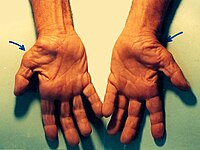
Photo from wikipedia
Objectives: Identify if Carpal tunnel syndrome (CTS) symptoms vary by measured biomechanical exposures. Methods: A nested prospective cohort within a large, multicenter, 8-year cohort study. The CTS case definition was… Click to show full abstract
Objectives: Identify if Carpal tunnel syndrome (CTS) symptoms vary by measured biomechanical exposures. Methods: A nested prospective cohort within a large, multicenter, 8-year cohort study. The CTS case definition was tingling/numbness in 2+ median nerve-served digits plus a nerve conduction study consistent with CTS. Workers were assigned to: (1) low (strain index [SI] less than or equal to 6.1), and (2) high (SI more than 6.1) job groups. Results: Among 1201 workers, 106 had CTS. Those in the high SI group became and remained symptom-free for at least 3 months, faster than the low SI group, adjusted hazard ratio (HR) = 2.07 (95% confidence interval [CI] = 1.21 to 3.56, P = 0.008). Only surgical release trended towards resolving CTS. Light duty had no impact, and job change was associated with delayed symptoms resolution. Conclusions: High biomechanical exposures paradoxically predicted faster improvement in CTS and light duty did not result in symptom resolution.
Journal Title: Journal of Occupational and Environmental Medicine
Year Published: 2019
Link to full text (if available)
Share on Social Media: Sign Up to like & get
recommendations!